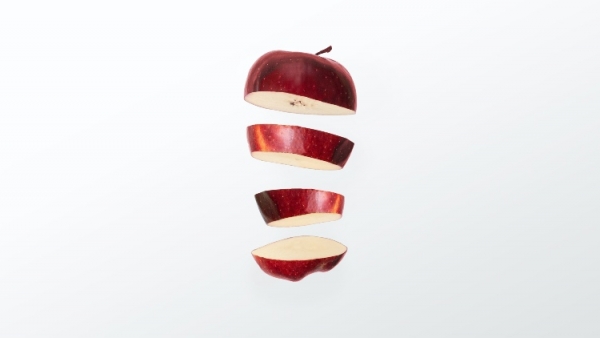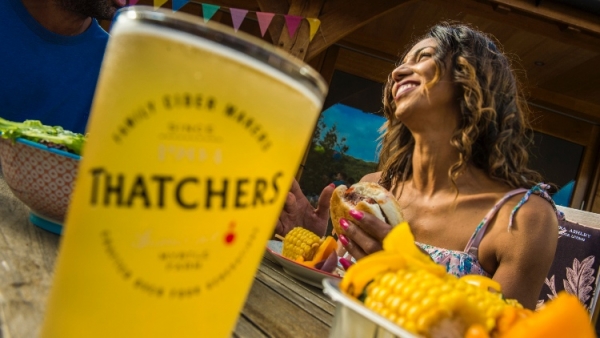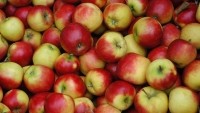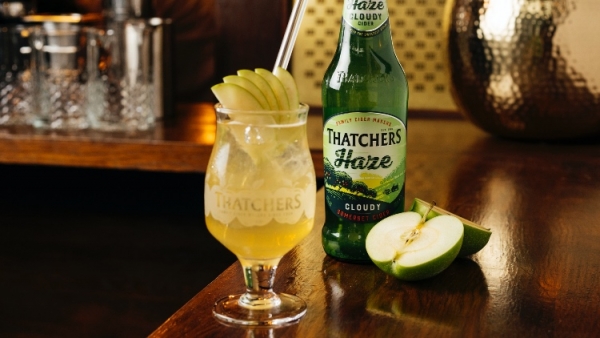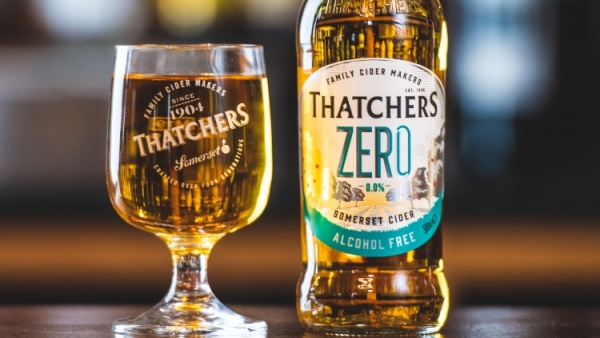In association with Thatchers
The A to Z of pub cider

With the help of Thatchers, The Morning Advertiser (MA) has spelled out what the cider category looks like as the pub sector hopes to sink its teeth into a summer of pub garden drinking, sport and (state sanctioned) socialising.
A – Apple
Where else can you start with a feature on cider? With some 7,500 varieties grown worldwide – and more than 250 UK apple varieties used for cider according to Discover Cider – it’s little wonder the category is so diverse.
More than half (55%) of the 122 new cider products introduced to the drinks market in 2019 were apple-based – compared to 39% fruit ciders – according to CGA, proving that despite the success of zany flavours, they still haven’t completely upset the apple cart.
“At the one end of the cider spectrum, flavoured ciders continue their grip on the taps and in the fridge,” cider expert Gabe Cook told The MA in October 2020. “At the other end however, is an increase in the number of brands that display more 'craft', 'artisan' or purely 'indie' credentials. These are ciders that put the apple at the forefront, often with a description of the varieties and processes used.”
B - British
Almost half (45%) of apples grown in the UK are used in cider according to campaign group Discover Cider.
And though the US boasts a burgeoning cider scene and places like the Basque Country and Brittany have led Europe’s charge, Britons remain the biggest consumers of cider per capita – with more than 600 domestic producers representing 39% of the global market according to the National Association of Cider Makers.
The body paints British cider as a “success story” yielding £100m exports to more than 50 countries spanning five continents per year – compared to roughly £54m in import from the European Community according to Statista.
C – Cider
Numerous historical accounts trace cider’s roots back to the Roman Empire, ancient Greece and the Middle East – while evidence also exists that Celts made cider from Britain’s crab apples as far back as the year 3000 BC, according to Great British Chefs.
Foreign invaders brought enhanced cidermaking techniques and technology to British shores – firstly the Romans, who pioneered apple cultivars and orcharding, followed by Norman conquerors in 1066 who arrived armed with new varieties of cider apples and new pressing procedures.
As a result, by the beginning of the 14th century, cidermaking had spread across England, and while what became known as the Little Ice Age took hold of western Europe until the 19th century, the humble apple’s ability to endure cooler temperatures than grapes saw its popularity spread further.
D – Dining out
With a palette of delicious and refreshingly diverse styles of cider, enhancing a meal with your favourite glass can be a real delight.
Whether you’re serving pub classics like fish and chips, aromatic curries, or grilling outdoors, there’s a cider that will bring out the best of flavours on your menu.
As a guide to matching the cider in your glass to the food on your plate, remember the three C’s of cider and food matching to find the ideal pairing:
Cleanse/cut – the natural fruit acids in cider provide a refreshing, mouth-watering quality, cutting through rich food with ease.
Complement – choose similar flavours in the cider and food to let them harmonise. Juicy, aromatic ciders can be paired with savoury dishes that feature fresh fruit or fruit sauces for example.
Contrast – fuller fruity ciders with rounded flavours work well with fragrant spicy dishes to create a balance of flavours.
E – Environment
Whether contributing to the biodiversity of our landscapes through acres of apple orchards, cutting carbon throughout production processes, minimising waste, or reducing plastic in packaging, many cidermakers have made impressive inroads in their sustainability credentials.
After all, when your generational home is a rural environment then care of the world around you comes as second nature.
Thatchers Cider’s orchards, for example, lock up some 182 tonnes of carbon each year as well as being home to a myriad of wildlife.
Its purpose-built energy centre harnesses energy from solar panels, waste heat and biomass, and nothing in the cidermaking process goes to waste – even the left-over apple (pomace) is used for cattle feed or anaerobic digestion.
If you’re looking for a green drink on your bar, cider is a great choice.
F – Fruit
Though apple variants are still core to any pub’s cider offer, the fact that – according to The MA’s 2021 Drinks List – half of the on-trade’s ten best-selling ciders were fruit or flavoured variants has given operators pours for thought.
According to CGA figures, strawberry and lime variants continue to be the pick of the flavoured cider category with strawberry and mixed or dark berry flavours delivering 79% of fruit cider sales in the 12 weeks to 23 May 2020.
What’s more, strawberry and mixed fruit flavours saw the biggest growth over the same period, growing by 55% and 62% respectively.
G – Gold
Thatchers Gold is the family cider maker’s flagship serve and, according to The MA’s 2021 Drinks List, saw 166,054 HL – almost 30m pints – sold at a combined value of more than £100m in 2020.
Now more than ever, operators need to choose a cider range that will demonstrate consumer appeal with Thatchers Gold a prime candidate to be welcomed by pub goers with its refreshing, “appley” taste.
According to CGA Brandtrack, 43% of consumers said they would continue to drink the premium brands they enjoyed during lockdown in 2020. Therefore, with Thatchers Gold value sales growing by 52.3% in the off trade, it’s a cider returning customers will be looking for when doors reopen.
H – Haze
When the on-trade reopened in July 2020, the market saw the thirst for cider continue with the category outperforming total alcohol according to CGA. Anticipate a similar thirst for cider this year.
An apple cider offer that includes a cloudy variant will give customers ample choice. Thatchers Haze, the UK’s number one cloudy cider brand, grew by 78% total trade in volume in the year to December 2020 and was the only new entry into the 10 best-selling on-trade ciders in The MA’s 2021 Drinks List, selling 39,853HL – more than 7m pints – at a cost of more than £25m.
By stocking the top performing pairing of Thatchers Haze, and Thatchers Gold – thereby appealing to both drier and sweeter tastes – operators sell 75% more cider than when Gold is paired with other variants.
I – Impulse
Speaking to The MA in 2019, publican Liz Aspden of the Harlequin in Sheffield, South Yorkshire - which was shortlisted for the Best Cider Pub for the Great British Pub Awards 2016 – pondered whether producers may plump for visually striking products rather than new flavour innovation in light of the consumer clamour for products like pink gin.
“In terms of future products in this category, I wonder whether we’ll see producers concentrating on colour rather than special flavours,” she says, “such as drinks that sound like they’ll be pink in appearance, regardless of whichever fruit is in there – a lot of drinkers drink by brand name.”
J – Juice
Apples are at the heart of all cider which, of course, starts with juice.
Apples are harvested from the end of August through to November each year. It’s important to press the juice as quickly as possible after harvesting in order to retain its freshness.
Once pressed, yeast is added to the juice and the fermentation process begins.
The perfect balance of temperature and time creates a fermentation that retains and develops the beautiful natural apple character and flavours of the juice.
K – Keg pledge
As the hospitality sector faced pandemic restrictions in 2020, more than 6,000 outlets were sent a free keg of cider by Thatchers as part of producer’s £1m pledge to support the industry.
With the backing of more than 60 leading wholesalers, brewers and pub partners, the cider maker was able to back both leased, tenanted and free trade outlets, offering support as they began to reopen in the summer and autumn.
Speaking after the cider maker’s Keg Pledge in June 2020, managing director Martin Thatcher said: “We want to help the pub industry get back to business after this immensely tough period. There’s no doubt pubs and bars will need all the help and support they can get, with the new normal being just as challenging.
“By giving customers across Britain, who currently stock one of our draught brands, a free keg of cider, we’re hoping that this will be of great value to them financially for when they’re able to get the pints pouring once again.”
L – Lockdown
Publicans are being encouraged to review their cider range during lockdown and be ready for reopening with a range that really works hard for them.
“Taking the time now to review your range and introduce ciders to the bar that can demonstrate consumer appeal and help boost profits, will be a job well done, and will ease the pressure on your time when re-opening is announced,” Rob Sandall, on-trade sales director at Thatchers, observes.
“Consumers have a connection with their favourite brands – they understand the care we take to make our cider sustainably and to the highest quality, but crucially they trust us to deliver a great tasting glass of cider every time.”
M – Myrtle Farm
Consumers have a strong loyalty to brands that can show provenance and authenticity.
Knowing where your cider is made, where the apples are grown, and the knowledge and experience that goes into that all adds to the credibility of brands.
With that in mind, did you know that many of Thatchers TV ads have been filmed at their family home at Myrtle Farm in Somerset?
The farm itself dates back hundreds of years, and the Thatcher family has been farming there since the 1800s. It was in 1904 when William Thatcher first started making cider there.
N – New occasions
According to CGA data, while on-trade cider pickings stood at £738.8m in summer 2019, combined autumn and winter cider sales totalled a fruitful £836.7m.
Additionally, more than 163m pints (928,981 HL) of draught cider were poured in pubs during autumn and winter 2019 compared to 142m (810,456 HL) in summer alone.
Though cider expert and founder of the Discover Cider campaign, Gabe Cook, acknowledges the “well-known fact” that cider is seen as a summertime drink by consumers, he remains puzzled by cider’s struggle to weather seasons and temperature in the same way lager does.
“Nothing slakes the thirst on a warm summer's day like a fresh, crisp, cold cider,” Cook told The MA in October. “But it is a real challenge for cider makers that, come the autumn, cider sales drop off a cliff.
“There is a lot of work to do to try and enable consumers to enjoy all different styles of cider appropriate to different times of year.”
O – Outdoors
Cider and hot weather go together like knife and fork with sales spiking by an average of 16% as the days grow longer, according to CGA.
However, an ice-cold cider doesn’t just pair well with warmer weather served up in pub gardens during the summer months, with the acidity of certain pours well suited to cutting through fried food, replicating a squeeze of lemon over grilled seafood, or complimenting a seasonal salad.
What’s more, if you’re getting the barbecue out, it’s worth remembering that a plated Sunday roast with all the trimmings isn’t the only place to pair pork and apple.
P – Pubs
With almost two thirds (62%) of every penny spent on cider in the UK handed over the bar at a pub, it’s no shock that the category is core to the on-trade.
In the year prior to the pandemic – pubs sold just shy of 3m hectolitres, or just over £2bn, of cider according to CGA.
Q – Quality
As part of the gravitation towards provenance and authenticity, Sandall adds that consumers increasingly plumped for premium ciders during lockdown.
“According to CGA Brandtrack, 43% of people said they’ll continue to drink the premium brands they enjoyed during lockdown, another opportunity for pubs to review their offer and restock according to the new normal that’s now with us,” he told The MA in October.
CGA research also found that roughly a third of all draught and packaged ciders sold in the on-trade before the current closure were premium varieties – with summer’s 33% slice pipping the 30% yielded by autumn and winter sales.
R – Rosé
What could be more tempting on a warm summer’s day than a refreshing glass of a fine Rosé? And we don’t mean wine.
Rosé Cider is a definite hit, and not just with those snapping food and drink for the ‘Gram. It’s really hit the mark for those who love a sweeter, fruitier, apple cider.
Thatchers introduced its Rosé two years ago when it added more than 1m litres to the apple cider category.
Now Rosé is coming out of the fridge and onto the bar on draught following 154% off-trade value sales growth in the past 12 months to December 2020.
S – Spring and summer opportunity
Before health secretary Matt Hancock joined the Government chorus declaring it was "too early" to know whether summer holidays can go ahead this year, almost three quarters (73%) of Brits revealed they were planning an overnight trip in the UK in 2021, according to a survey by TripAdvisor.
With so many people potentially staying on home soil for their holidays this year, pubs, bars and holiday parks can maximise any staycation opportunities by adapting to increased footfall, having the right brands on their bar, and deploying effective marketing promotions to support.
It’s a reality we’re all facing up to – 2021 is going to be the summer of the UK staycation.
So, when we’re allowed out, let’s make it a year to remember and offer visitors to our hometowns and cities some great British hospitality with British brands we’re all proud of.
T – Tradition
The notion of farmers out in the fields picking cider apples, then pressing them with traditional style presses may have a romantic feel to it – but if you think that’s how cider is made now, you may be shocked to your core.
Learnings of past years have been translated into today’s technology to bring state of the art cider making that allows for innovation and creativity to go hand in hand with quality and expertise.
U – Untapped
For bar top variety there are some amazing ciders that are relatively unknown and ripe for the picking for anyone looking for something more unusual. Thatchers Rascal is just one of those – definitely worth a detour for.
While post-lockdown customers initially craved comfort and normality in pubs – meaning they often plumped for classic brands and experimented less – cider expert Gabe Cook previously told The MA that now pubs have been open for a while nostalgia for classic brands is making way for curiosity.
“There is a whole tranche of drinkers who are constantly looking for the next interesting trend, but they need the opportunity to experiment and sample,” he said. “This is where having a 'craft keg' or well cellared bag in box cider could come to the fore.”
Susanna Forbes, a cider expert, author and co-founder of Little Pomona, echoed Cook, adding: “Anecdotally I heard that during lockdown, consumers had become more willing to experiment.
“They had to seek out good cider anyway, so now their horizons have widened, they want to keep exploring.
“So there is a big opportunity for go-ahead publicans and restaurateurs to feed that sense of exploration and excitement.”
V – Value
While cider experienced the biggest overall percentage drop in volume and value sales of any segment on The MA’s2021 Drinks List due to pubs being closed during one of the hottest summers on record, the great British public still managed to squeeze in 193,572,938m pints of the on-trade’s top 10 selling cider brands during 2020.
The Government’s Eat Out to Help Out Scheme helped boost cider in pubs with the category’s sales value 10.1% ahead of where it was in 2019 according to the CGA Drinks Recovery Tracker.
What’s more, the average price a pint of cider rose by just 6p year on year in 2020 to £3.88 according to research in November 2020.
W – West Country
With enhanced cider making techniques having landed in Britain alongside Roman and Norman invaders, cider orchards – and drinking – quickly spread across the four corners of the country.
However, given soil conditions and warmer climates in the counties that now make up the West Country were more suited to apple growing, the region became the country’s leading cidermaking region.
The apple hasn’t fallen far from the tree and, today, the UK’s biggest and most successful cidermakers still call the region home, with Thatchers’ own base on Myrtle Farm in Somerset dating back hundreds of years.
X – E(x)perience
When it comes to what makes customers return time and time again to your business, we know it’s about the personal service, and attention to detail that outstanding operators are proud of.
Offering an experience to remember can encompass many different aspects of running a pub. Try experimenting with Cider Cocktails to offer your customers something deliciously different.
What’s more, Alistair Morrell of Cider is Wine states that if operators are to coax consumers back into hospitality they must “surprise and delight” in order to retain them.
“For example, ciders and perries – authentically made from 100% juice – served as wine are excellent lunchtime and informal drinking opportunities, because they have half the alcohol of a bottle of wine.
“Put the suggestion out there and own the idea - the right consumers love it.”
Y – Younger drinkers
Millennials and Generation Z appear particularly sweet on fruity and more experimental cider variants – not to mention low and no pours which chime with their increased focus on health , wellbeing and getting their apple a day.
“In the past few years, we have seen lots of new flavours being introduced to cider to encourage a younger trendier clientele,” Andy Mounsey, who operates the Star at Godalming in Surrey told The MA in 2019
“In the hotter coming months, we are expecting lots of pineapple coconut and mango flavours, exotic and maybe spicy,” he adds.
Hawkes cider founder Simon Wright adds that these pours – deemed controversial by traditionalists – are an increasingly important entry point to the wider cider category for younger drinkers.
“As a growing cider maker you’ve got to realise there’s a market for it and cater accordingly,” he told The MA in May 2019.
Z – Zero
Consumers are putting health and well being at the top of their priority list – in a society reeling from Covid, the low and no category is here to stay – particularly in the 18 to 24 age group.
But it’s fair to say that it’s been a category slow to embrace range and quality, but now, with new entrants to the market such as Thatchers Zero Cider, there are alcohol free and low alcohol variants that are turning heads.
Consumers are voting with their feet and opting for low and no drinks that are refreshing, full of taste – and in truth are just as characterful as their alcohol counterparts. They’re a must stock for pubs and bars looking to offer their customers what they’re asking for.







